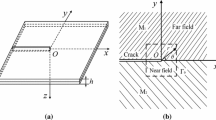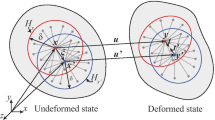Abstract
A frequency-domain approach based on the semi-analytical scaled boundary finite element method (SBFEM) was developed to calculate dynamic stress intensity factors (DSIFs) at bimaterial interface cracks subjected to transient loading. Because the stress solutions of the SBFEM in the frequency domain are analytical in the radial direction, and the complex stress singularity at the bimaterial interface crack tip is explicitly represented in the stress solutions, the mixed-mode DSIFs were calculated directly by definition. The complex frequency-response functions of DSIFs were then used by the fast Fourier transform (FFT) and the inverse FFT to calculate time histories of DSIFs. A benchmark example was modelled. Good results were obtained by modelling the example with a small number of degrees of freedom due to the semi-analytical nature of the SBFEM.
Similar content being viewed by others
References
Chen W H, Wu C W. On elastodynamic fracture mechanics analysis of bimaterial structures using finite element method. Engin Fract Mech, 1981, 15(1–2): 155–168
Geubelle P H. A numerical method for elastic and viscoelastic dynamic fracture problems in homogeneous and bimaterial systems. Computat Mech, 1997, 20: 20–25
Marur P R, Tippur H V. Dynamic response of bimaterial and graded interface cracks under impact loading. Int J Fract, 2000, 103: 95–109
Dineva P, Gross D, Rangelov T. Dynamic behavior of a bimaterial interface-cracked plate. Engin Fract Mech, 2002, 69(11): 1193–1218
Lira-Vergara E, Rubio-Gonzalez C. Dynamic stress intensity factor of interfacial finite cracks in orthotropic materials. Int J Fract, 2005, 135: 285–309
Xu X P, Needleman A. Numerical simulations of dynamic crack growth along an interface. Int J Fract, 1996, 74: 289–324
Nishioka T, Hu Q H, Fujimoto T. Component separation method of the dynamic J integral for evaluating mixed-mode stress intensity factors in dynamic interfacial fracture mechanics problems. JSME Int J Ser A-Solid Mech Mater Engin, 2002, 45(3): 395–406
Dornowski W, Perzyna P. Numerical analysis of macrocrack propagation along a bimaterial interface under dynamic loading processes. Int J Solids Struct, 2002, 39: 4949–4977
Lei J, Wang Y S, Gross D. Time-domain BEM analysis of a rapidly growing crack in a bimaterial. Int J Fract, 2004, 126(2): 103–121
Wolf J P, Song C M. Finite-element Modelling of Unbounded Media. Chichester: John Wiley and Sons, 1996
Wolf J P. The Scaled Boundary Finite Element Method. Chichester: John Wiley and Sons, 2003
Deeks A J, Chidgzey S R. Determination of coefficients of crack tip asymptotic fields using the scaled boundary finite element method. Engin Fract Mech, 2005, 72(13): 2019–2036
Song C M, Wolf J P. Semi-analytical representation of stress singularities as occurring in cracks in anisotropic multi-materials with the scaled boundary finite-element method. Comput & Struct, 2002, 80(2): 183–197
Yang Z J. Fully automatic modelling of mixed-mode crack propagation using scaled boundary finite element method. Engin Fract Mech, 2006, 73(12): 1711–1731
Song C M. A super-element for crack analysis in the time domain. Int J Num Methods Engin, 2004, 61(8): 1332–1357
Song C M, Wolf J P. The scaled boundary finite-element method: Analytical solution in frequency domain. Comput Methods Appl Mech Engin, 1998, 164(1–2): 249–264
Yang Z J, Deeks A J, Hao H. A Frobenius solution to the scaled boundary finite element equations in frequency domain. Int J Num Methods Engin, 2007, 70(12): 1387–1408
Deeks A J, Wolf J P. A virtual work derivation of the scaled boundary finite-element method for elastostatics. Comput Mech, 2002, 28(6): 489–504
Yang W, Suo Z, Shih C F. Mechanics of dynamic debonding. Proc Roy Soc London Ser A-Math Phys Engin Sci, 1991, 433(1889): 679–697
Sun C T, Jih C J. On strain energy release rates for interfacial cracks in bimaterial media. Engin Fract Mech, 1987, 28(1): 13–20
Cooley J W, Tukey J W. An algorithm for the machine calculation of complex Fourier series. Math Comput, 1965, 19: 297–301
MATLAB V7.1. The MathWorks, Inc, 2005
Author information
Authors and Affiliations
Corresponding author
Additional information
Supported by the Scientific Research Foundation for the Returned Overseas Chinese Scholars, Ministry of Education of China (Grant No. J20050924) and the Australian Research Council Discovery Project (Grant No. DP0452681)
Rights and permissions
About this article
Cite this article
Yang, Z.J., Deeks, A.J. Calculation of transient dynamic stress intensity factors at bimaterial interface cracks using a SBFEM-based frequency-domain approach. Sci. China Ser. G-Phys. Mech. As 51, 519–531 (2008). https://doi.org/10.1007/s11433-008-0057-y
Received:
Accepted:
Published:
Issue Date:
DOI: https://doi.org/10.1007/s11433-008-0057-y




